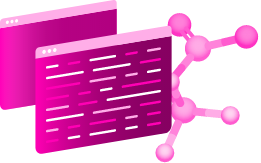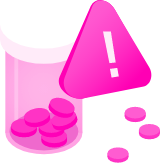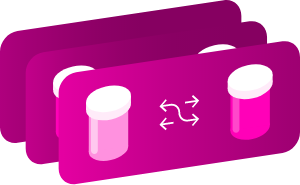Identification
- Generic Name
- Anisindione
- DrugBank Accession Number
- DB01125
- Background
-
Anisindione is a synthetic anticoagulant and an indanedione derivative. Its anticoagulant action is mediated through the inhibition of the vitamin K-mediated gamma-carboxylation of precursor proteins that are critical in forming the formation of active procoagulation factors II, VII, IX, and X, as well as the anticoagulant proteins C and S, in the liver.
- Type
- Small Molecule
- Groups
- Approved
- Structure
- Weight
-
Average: 252.2647
Monoisotopic: 252.07864425 - Chemical Formula
- C16H12O3
- Synonyms
-
- 2-(4-Methoxyphenyl)-1H-indene-1,3(2H)-dione
- 2-(4-Methoxyphenyl)indan-1,3-dione
- 2-(p-Methoxyphenyl)-1,3-indandione
- 2-(p-Methoxyphenyl)indane-1,3-dione
- 2-p-Anisyl-1,3-indandione
- 2-para-Anisyl-1,3-indandione
- Anisin indandione
- Anisindiona
- Anisindione
- Anisindionum
Pharmacology
- Indication
-
For the prophylaxis and treatment of venous thrombosis and its extension, the treatment of atrial fibrillation with embolization, the prophylaxis and treatment of pulmonary embolism, and as an adjunct in the treatment of coronary occlusion.
 Reduce drug development failure ratesBuild, train, & validate machine-learning models
Reduce drug development failure ratesBuild, train, & validate machine-learning models
with evidence-based and structured datasets.Build, train, & validate predictive machine-learning models with structured datasets. - Contraindications & Blackbox Warnings
-
 Avoid life-threatening adverse drug eventsImprove clinical decision support with information oncontraindications & blackbox warnings, population restrictions, harmful risks, & more.Avoid life-threatening adverse drug events & improve clinical decision support.
Avoid life-threatening adverse drug eventsImprove clinical decision support with information oncontraindications & blackbox warnings, population restrictions, harmful risks, & more.Avoid life-threatening adverse drug events & improve clinical decision support. - Pharmacodynamics
-
Anisindione is a synthetic anticoagulant and an indanedione derivative. It is prescribed only if you cannot take coumarin-type anticoagulants such as coumadin as anisindione is a powerful drug with serious potential side effects. Anticoagulants decrease the clotting ability of the blood and therefore help to prevent harmful clots from forming in the blood vessels. These medicines are sometimes called blood thinners, although they do not actually thin the blood. They also will not dissolve clots that already have formed, but they may prevent the clots from becoming larger and causing more serious problems.
- Mechanism of action
-
Like phenindione, to which it is related chemically, anisindione exercises its therapeutic action by reducing the prothrombin activity of the blood. By inhibiting the vitamin K–mediated gamma-carboxylation of precursor proteins, the formation of active procoagulation factors II, VII, IX, and X, as well as the anticoagulant proteins C and S is prevented. Anisindione has no direct thrombolytic effect and does not reverse ischemic tissue damage, although it may limit extension of existing thrombi and prevent secondary thromboembolic complications.
Target Actions Organism AVitamin K-dependent gamma-carboxylase inhibitorHumans - Absorption
-
积累不出现重复给药。
- Volume of distribution
-
Not Available
- Protein binding
-
Not Known
- Metabolism
- Not Available
- Route of elimination
-
Not Available
- Half-life
-
Not Known
- Clearance
-
Not Available
- Adverse Effects
-
 Improve decision support & research outcomesWith structured adverse effects data, including:blackbox warnings, adverse reactions, warning & precautions, & incidence rates.Improve decision support & research outcomes with our structured adverse effects data.
Improve decision support & research outcomesWith structured adverse effects data, including:blackbox warnings, adverse reactions, warning & precautions, & incidence rates.Improve decision support & research outcomes with our structured adverse effects data. - Toxicity
-
An overdose is likely to cause abnormal bleeding, for which the symptoms include: bleeding from gums or nose, blood in urine or stools, excessive bleeding from minor cuts, patches of discoloration or bruises on the skin.
- Pathways
- Not Available
- Pharmacogenomic Effects/ADRsBrowse all" title="" id="snp-actions-info" class="drug-info-popup" href="javascript:void(0);">
- Not Available
Interactions
- Drug InteractionsLearn More" title="" id="structured-interactions-info" class="drug-info-popup" href="javascript:void(0);">
-
这些信息不应该interpreted without the help of a healthcare provider. If you believe you are experiencing an interaction, contact a healthcare provider immediately. The absence of an interaction does not necessarily mean no interactions exist.Not Available
- Food Interactions
- Not Available
Products
-
 Drug product information from 10+ global regionsOur datasets provide approved product information including:
Drug product information from 10+ global regionsOur datasets provide approved product information including:
dosage, form, labeller, route of administration, and marketing period.Access drug product information from over 10 global regions. - International/Other Brands
- Miradon/Unidone
Categories
- Drug Categories
- Chemical TaxonomyProvided byClassyfire
-
- Description
- This compound belongs to the class of organic compounds known as indanediones. These are compounds containing an indane ring bearing two ketone groups.
- Kingdom
- Organic compounds
- Super Class
- Benzenoids
- Class
- Indanes
- Sub Class
- Indanones
- Direct Parent
- Indanediones
- Alternative Parents
- Phenoxy compounds/Methoxybenzenes/Aryl alkyl ketones/Anisoles/Beta-diketones/Alkyl aryl ethers/Organic oxides/Hydrocarbon derivatives
- Substituents
- 1,3-dicarbonyl compound/1,3-diketone/Alkyl aryl ether/Anisole/Aromatic homopolycyclic compound/Aryl alkyl ketone/Aryl ketone/Ether/Hydrocarbon derivative/Indanedione
- Molecular Framework
- Aromatic homopolycyclic compounds
- External Descriptors
- aromatic ketone, beta-diketone (CHEBI:133809)
- Affected organisms
-
- Humans and other mammals
Chemical Identifiers
- UNII
- S747T1ERAJ
- CAS number
- 117-37-3
- InChI Key
- XRCFXMGQEVUZFC-UHFFFAOYSA-N
- InChI
-
InChI=1S/C16H12O3/c1-19-11-8-6-10(7-9-11)14-15(17)12-4-2-3-5-13(12)16(14)18/h2-9,14H,1H3
- IUPAC Name
-
2-(4-methoxyphenyl)-2,3-dihydro-1H-indene-1,3-dione
- SMILES
-
COC1=CC=C(C=C1)C1C(=O)C2=CC=CC=C2C1=O
References
- Synthesis Reference
-
Sperber, N.; US. Patent 2,899,358; August 11, 1959; assigned to Schering Corporation
- 一般引用
-
- CONNELL WF, MAYER GA: Evaluation of anticoagulant therapy with anisindione (miradon). Can Med Assoc J. 1959 May 15;80(10):785-90. [Article]
- External Links
-
- Human Metabolome Database
- HMDB0015257
- KEGG Drug
- D07457
- PubChem Compound
- 2197
- PubChem Substance
- 46504660
- ChemSpider
- 2112
- BindingDB
- 50280155
- 17941
- ChEBI
- 133809
- ChEMBL
- CHEMBL712
- ZINC
- ZINC000100015486
- Therapeutic Targets Database
- DAP001274
- PharmGKB
- PA164746467
- RxList
- RxList Drug Page
- Drugs.com
- Drugs.com Drug Page
- PDRhealth
- PDRhealth Drug Page
- Wikipedia
- Anisindione
Clinical Trials
- Clinical TrialsLearn More" title="" id="clinical-trials-info" class="drug-info-popup" href="javascript:void(0);">
-
Phase Status Purpose Conditions Count
Pharmacoeconomics
- Manufacturers
-
Not Available
- Packagers
-
Not Available
- Dosage Forms
- Not Available
- Prices
- Not Available
- Patents
- Not Available
Properties
- State
- Solid
- Experimental Properties
-
Property Value Source melting point (°C) 155-156 Sperber, N.; US. Patent 2,899,358; August 11, 1959; assigned to Schering Corporation water solubility 79.8 mg/L Not Available logP 2.88 SANGSTER (1993) - Predicted Properties
-
Property Value Source Water Solubility 0.0128 mg/mL ALOGPS logP 2.99 ALOGPS logP 2.72 Chemaxon logS -4.3 ALOGPS pKa (Strongest Acidic) 4.55 Chemaxon pKa (Strongest Basic) -4.8 Chemaxon Physiological Charge -1 Chemaxon Hydrogen Acceptor Count 3 Chemaxon Hydrogen Donor Count 0 Chemaxon Polar Surface Area 43.37 Å2 Chemaxon Rotatable Bond Count 2 Chemaxon Refractivity 71.7 m3·mol-1 Chemaxon Polarizability 26.3 Å3 Chemaxon Number of Rings 3 Chemaxon Bioavailability 1 Chemaxon Rule of Five Yes Chemaxon Ghose Filter Yes Chemaxon Veber's Rule No Chemaxon MDDR-like规则 No Chemaxon - Predicted ADMET Features
-
Property Value Probability Human Intestinal Absorption + 1.0 Blood Brain Barrier + 0.9051 Caco-2 permeable + 0.8206 P-glycoprotein substrate Non-substrate 0.6289 P-glycoprotein inhibitor I Inhibitor 0.5099 P-glycoprotein inhibitor II Non-inhibitor 0.534 Renal organic cation transporter Non-inhibitor 0.8467 CYP450 2C9 substrate Non-substrate 0.7584 CYP450 2D6 substrate Non-substrate 0.8872 CYP450 3A4 substrate Non-substrate 0.5965 CYP450 1A2 substrate Inhibitor 0.9594 CYP450 2C9 inhibitor Inhibitor 0.8996 CYP450 2D6 inhibitor Non-inhibitor 0.9457 CYP450 2C19 inhibitor Inhibitor 0.6234 CYP450 3A4 inhibitor Non-inhibitor 0.8639 CYP450 inhibitory promiscuity High CYP Inhibitory Promiscuity 0.6618 Ames test AMES toxic 0.6006 Carcinogenicity Non-carcinogens 0.8733 Biodegradation Not ready biodegradable 0.8575 Rat acute toxicity 2.4052 LD50, mol/kg Not applicable hERG inhibition (predictor I) Weak inhibitor 0.944 hERG inhibition (predictor II) Non-inhibitor 0.8898
Spectra
- Mass Spec (NIST)
- Not Available
- Spectra
-
Spectrum Spectrum Type Splash Key Predicted GC-MS Spectrum - GC-MS Predicted GC-MS Not Available Predicted MS/MS Spectrum - 10V, Positive (Annotated) Predicted LC-MS/MS Not Available Predicted MS/MS Spectrum - 20V, Positive (Annotated) Predicted LC-MS/MS Not Available Predicted MS/MS Spectrum - 40V, Positive (Annotated) Predicted LC-MS/MS Not Available Predicted MS/MS Spectrum - 10V, Negative (Annotated) Predicted LC-MS/MS Not Available Predicted MS/MS Spectrum - 20V, Negative (Annotated) Predicted LC-MS/MS Not Available Predicted MS/MS Spectrum - 40V, Negative (Annotated) Predicted LC-MS/MS Not Available
Targets

insights and accelerate drug research.
- Kind
- Protein
- Organism
- Humans
- Pharmacological action
-
Yes
- Actions
-
Inhibitor
- General Function
- Gamma-glutamyl carboxylase activity
- Specific Function
- Mediates the vitamin K-dependent carboxylation of glutamate residues to calcium-binding gamma-carboxyglutamate (Gla) residues with the concomitant conversion of the reduced hydroquinone form of vit...
- Gene Name
- GGCX
- Uniprot ID
- P38435
- Uniprot Name
- Vitamin K-dependent gamma-carboxylase
- 分子量
- 87560.065 Da
References
- Overington JP, Al-Lazikani B, Hopkins AL: How many drug targets are there? Nat Rev Drug Discov. 2006 Dec;5(12):993-6. [Article]
- Imming P, Sinning C, Meyer A: Drugs, their targets and the nature and number of drug targets. Nat Rev Drug Discov. 2006 Oct;5(10):821-34. [Article]
- Chen X, Ji ZL, Chen YZ: TTD: Therapeutic Target Database. Nucleic Acids Res. 2002 Jan 1;30(1):412-5. [Article]
- Source [Link]
Drug created at June 13, 2005 13:24 / Updated at May 07, 2021 21:23




